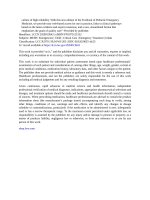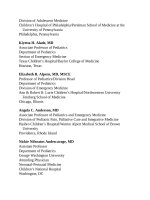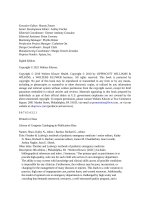Pediatric emergency medicine trisk 2714 2714
Bạn đang xem bản rút gọn của tài liệu. Xem và tải ngay bản đầy đủ của tài liệu tại đây (44.02 KB, 1 trang )
Radiation to the marrow cavity, especially including the spine or pelvis, can also
cause myelosuppression during treatment and/or delayed recovery after treatment. In
addition, cytopenias are a common finding in patients with newly diagnosed
leukemia.
Significant neutropenia is usually defined as an ANC below 500 cells/μL. The
ANC is calculated by multiplying the percentage of WBCs that are neutrophils or
bands by the total WBC count. Patients with an ANC below 500 have an increased
risk of bacterial infections due to insufficient numbers of phagocytic cells to fight
bacteria. This risk increases dramatically when the ANC is below 100. Patients may
develop infections with bacteria that are not pathogens in normal hosts. The risk of
fungal infections increases with prolonged (more than 21 days) and severe (ANC
below 500) neutropenia. The infectious risks of neutropenia are increased by a
number of contributing factors. Indwelling foreign bodies such as central lines,
ventriculoperitoneal shunts, and bone allografts provide a foreign surface that
increases the likelihood of infection and the difficulty of treatment. The mucosal
injury that typically accompanies myelosuppression increases the risk of bacteria
entering the circulation through translocation across disrupted mucosal surfaces.
Immunosuppression decreases phagocytic function as well.









